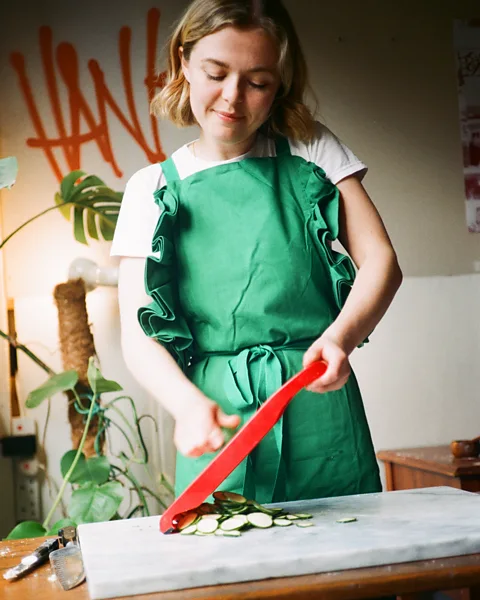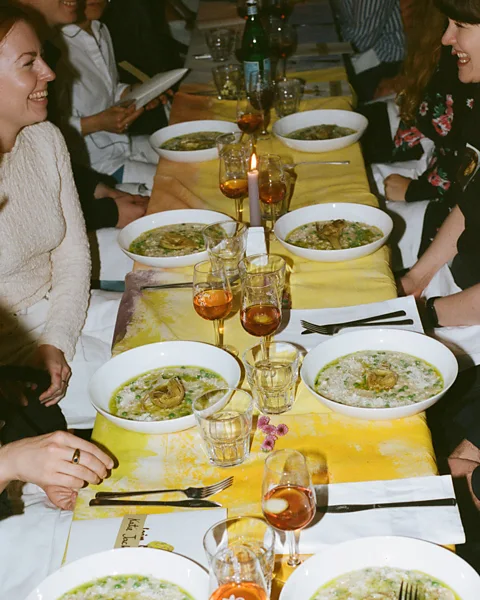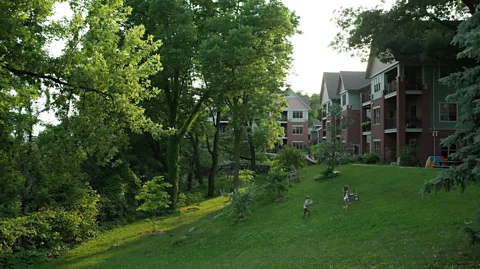As the cost of living rises and loneliness becomes a global concern, "intentional communites" are increasingly popular. We meet co-living members to explore the pros and cons.
Living with strangers? Always-occupied toilets, unwashed dishes in the kitchen, and people playing loud music in the room next to yours when you're trying to sleep?
Maybe it doesn't have to be that way. As housing and rental costs remain high, and after the World Health Organisation has declared loneliness a global health concern, communal living is gaining media attention and community-led living arrangements are increasing.
Maybe making a home with others is more good than bad. The question is if society is ready.
 Benedikte Kluver
Benedikte Kluver
Kellett lives with six other people in their late 20s and early 30s. Every week, they each put £25 into a shared bank account to cover the cost of household and cooking materials, bin bags, cleaning products and everyone's dinner. Every night, one person cooks. On a shared group chat, people confirm if they'll be in for dinner, if they want a late plate saved for when they come home, or if they are bringing a guest.
There are house chores – and house meetings. "It takes multiple WhatsApp polls to get a window of half an hour when everyone's in," Kellett tells the BBC, "but we try to do them as regularly as possible so that if anyone's unhappy with their chores, or if there's anything anyone wants to discuss, that doesn't fester".
 Benedikte Kluver
Benedikte KluverThe best thing about living communally, she says, is that there's always someone around. The housemates feel like a family. "I've never felt that way, really, about people I've lived with before." In London, she adds, the housing crises makes it very hard to find a home. "I think it's becoming increasingly difficult to live a good life here... this for me is like we've gotten through the little crack in the system."
There are drawbacks, too. Kellett has to work hard to ensure she gets some me time. "I can find it quite difficult to tear myself away from a big table full of people," she says. And even if you opt out of a party, you will still hear it. There are two showers and two toilets, which the housemates share without too much problem, but one washing machine isn't quite enough."
More like this:
People living in the communal warehouse tend to stay for a few years. Other communal living spaces, though, are set up for more permanent living. Creal Zearing, 36, lives with her husband and three-year-old daughter in a co-house community in Madison, Wisconsin in the US.
 Creal Zearing
Creal Zearing"My husband bought the first unit that we lived in. He started looking after we'd been dating for, like, three months," Zearing tells the BBC. "I knew what co-housing was, and I was like, this is cool. If we stay together I could end up really liking it. And sure enough, things have worked out between us."
The Arbco co-housing estate has two apartment blocks and a handful of single-family houses. Each unit has its own bedroom, bathroom and kitchen. Around 100 people live here, ranging from families with children to single older people. "Technically, our co-house is a condominium association – legally, that's how it's structured," Zearing explains. "We own our house, but we pay a condo fee every month, and that helps subsidise the community spaces that we utilise, and covers some insurance on our house."
Co-living tips
Residents put on meals every few weeks, and there are social events like a monthly singalong and parties. There is a member meeting every fortnight, and board and committee meetings, too. "I work full time," Zearing says. "But there are a bunch of people who are retired, and there's probably more regular stuff that they do together that I miss." Each resident is expected to contribute four hours of work a month.
"What I really, really value is that we have a great community of parents," Zearing says. "As a new mother I've been able to really lean on those parents for advice." She also loves how she can come home from work, tired, and simply take her daughter out into the backyard to play with other kids. Friends and company are readily available.
Not everything is straightforward, though. The co-house community just had a big meeting about participation. "Many of us who are actively engaged feel like they're doing all they can do. And yet you see some people who aren't presumably doing anything," Zearing says. "But there's a lot of invisible work that goes on." Her husband has been burnt a few times, after suggesting new ways of doing things, and meeting resistance.
'Intentional communities'
There is a wide spectrum of communal living setups in the Western world, and they have emerged for various reasons – in the UK, according to The Guardian, the Covid-19 pandemic contributed to the increase of interest in communal living. The members of one successful communal-living centre in Suffolk told the BBC in 2023 that their set-up was helping to protect them from the cost-of-living crisis.
"It can be really confusing," says Penny Clark, who is on the board of community-living organisation Diggers and Dreamers, and specialises in "intentional communities" – homes where, according to the academic definition, five or more unrelated people live voluntarily together. In co-housing, people have their own self-contained homes as well as dedicated communal spaces, and the community is self-managed, she explains, whereas in housing co-ops, the ownership is shared – but the estate doesn't always feel like an intentional community.
 Getty Images
Getty ImagesThere is also the relatively new sector of co-living, for which Clark consults as part of Conscious Coliving. Here, a company creates a building with self-contained apartments or studios as well as common areas, but these are not intentional communities either. "And then, very rare in the UK these days, are communes. According to academic definitions, what makes a commune particularly different to other types of community is that there's a high degree of income sharing. Your earnings go into the pot and you just spend things together."
What about Kellett's warehouse or those living in close-knit house shares, with people they consider close friends or even family? They can count as intentional communities, Clark says; they may just be less organised and more organic since they have fewer members.
More people may be turning towards communal living because the housing market is so pressured, Clark says. Some seek it out because they want to be more environmentally sustainable. And of course, in today's atomised society, where family members may be spread far and wide from the town where they were born, social connection is a big draw. In fact, research shows that people who live in intentional communities have a quality of life as high as the happiest people in society.
Is this way of living for everyone? "There's definitely compromises," says Clark. "The work that goes into community life can be a bit overwhelming – sometimes it turns out very badly, and people leave very upset."
 Getty Images
Getty ImagesIt is also difficult to create a new co-housing community. It's hard to find land, the financial risks are big, and banks are hesitant to lend money. "We're in a system that has certain assumptions about what a good life is, and a good home. And communal living doesn't fit into those assumptions", Clark says. "In society we have this mindset that privacy is good, and that owning things is good." Sharing your living space, she says, is not aspirational. "The idea of a good home is a big house that you own by yourself."
Meanwhile, existing communities like Arbco gets regular inquiries from people wanting to move in. Over in London, after Rosie Kellett shared two Instagram videos about her living setup, many people contacted her asking if they could move in. "I felt terrible because we were not taking in new roommates," she says. "Definitely there is a desire for there to be more spaces like this, but you kind of have to organise it for yourself."
--
If you liked this story, sign up for The Essential List newsletter – a handpicked selection of features, videos and can't-miss news delivered to your inbox twice weekly.


Post a Comment